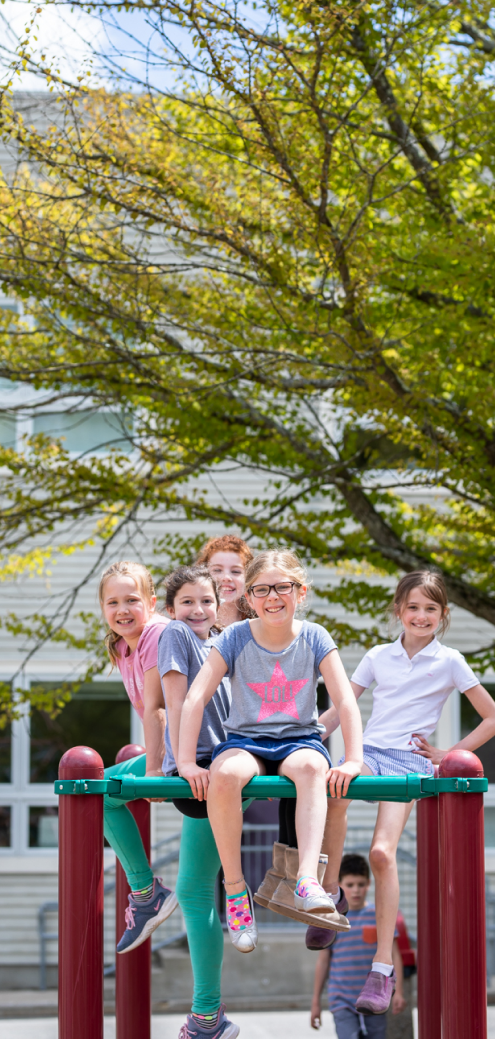It is 10:25 in the morning, and I need to head outside for my recess duty. There are four of us with this responsibility today, so for the next 25 minutes we will position three of us outside in “strategic” positions while a fourth member spends time in the second floor hallway encouraging students to head outside. Luckily the weather is cooperating, and it is sunny and in the 60’s. My job is to stand on the terrace, dispense snacks, and keep an eye on the play structure and basketball court. A colleague will oversee the lower field and “creek,” an area off to the side that features a wooded area and creek, a favorite of a devoted group of students from all three grades of the middle school. Another teacher will cover the pavilion and pine grove, asking students to remain in the level area and to avoid both the rocky hill and the poison ivy, a hazard in both September and late May.
Most students come out almost instantaneously, securing their mid-morning sustenance before looking for either a comfortable peer group or a favorite activity. A few will choose to calmly sit in adirondack chairs on the terrace, with a small group trying to decide which card game to play. While the creek and pine grove see a smattering of attendees, most congregate on the field for a game of tag–similar to Red Rover or on the basketball court.
The children on the basketball court are an interesting melange of boys and girls of different grade levels. What they all have in common is an interest in playing some form of basketball. They don’t always agree, but the two-on-two tournament seems to have garnered the most attention. The players team up, but not necessarily how one might predict. The playing is intense, and I can hear the occasional praise alongside a few playful taunts, but then, suddenly, a dispute is loudly aired. I can see a few students angrily arguing something related to the game.
This is where I come in. My instincts are all over the place. Do I intervene and make sure that the game plays along smoothly, without any discord? Do I model how I hope each player treats each other? Do I shut the game down, expressing how the children need to learn to work collaboratively? That’s when I fully realize the students need to learn for themselves how to work together, to voice their opinions as well as being ready to listen to others. They need to experience conflict, and do their best to find a resolution. I ultimately understand, my responsibility is to observe and remain at a distance. While it may be helpful later to provide some guidance, this moment is where these children will learn the social-emotional skills needed to be an effective member of a community, where students develop independence and resilience, and are inspired “to become caring, ethical members of the larger world, emphasizing thoughtful citizenship and respect for self and others,” to quote DCD’s mission statement.
Jonathan Haidt noted in The Anxious Generation that “Students would be healthier, happier, and smarter overall, with lower rates of injury and anxiety, if schools could loosen the reins and let children play in a more natural way.” In summary he poised, “Give kids more of it [recess], on better playgrounds, with fewer rules.”
The New Oxford American Dictionary defines recess as a break between school classes. This “break” is vitally important because it provides unstructured time where the students, through trial and error, learn how to be self aware, how to manage their behavior and actions, how to relate with and work effectively with peers and how to make good choices. It requires making mistakes and trying out different strategies, all while trying to understand one’s place in the world of middle school.
Mindful Practices, an online publication, espoused, “The playground is SEL in action. When students are let loose to interact with each other on their own terms, they have an opportunity to practice what they have been learning in the classroom. All five key SEL skills play out on the playground. Children are making decisions while practicing relational skills and social awareness. They also must manage their own emotions in response to the potentially chaotic nature of play.”
In an USDA Agricultural Research Service article titled The Crucial Role of Recess, Leah Whigham penned, “The peer interactions that occur during the unstructured free play that happens at recess promote social and emotional learning and development in children. Kids learn important communication skills during recess with situations that require cooperation, problem-solving, negotiation, and compromise.”
Unfortunately too many middle schools have either removed recess altogether or have cut back the time to make way for more programming. At DCD we have also felt the crunch of where to add new curricula and programming needs, but we have never lost sight of the importance of recess, providing unstructured time for the children to play. In fact, one of the silver linings during the pandemic was an influx of more time for recess outside. It greatly helped the students manage the stress of that time. Middle school features two recess periods daily, one twenty-five minute block mid morning and another ten-minute block following lunch. Teachers are also able to give short “recess” breaks when needed during class periods, advisory and study hall.
The dispute that began that day between students on the basketball court was ultimately resolved, not by me, a teacher, but by themselves. It may not have been a perfect resolution, but each child learned more about how to interact with each other and how to conduct oneself. They will undoubtedly have more conflicts, but each time will lead to more growth, eventually promoting what our former Head of School, Nick Thacher, referred to as “healthy thirty-year olds.”
I, too, learned a valuable lesson from recess duty: less is more. By taking a step back and allowing children the time to make mistakes in an unstructured environment can help them become “caring, ethical members of the larger world.”
Written by: Nate Buffum | Head of Middle School & Grade 8 History Teacher







